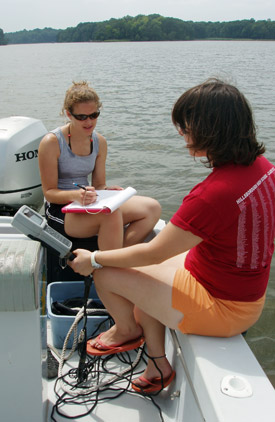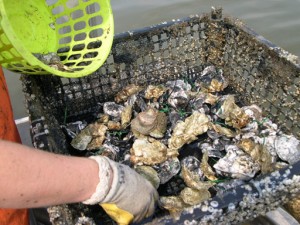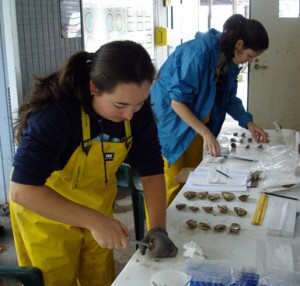
Two summer interns measure the water's dissolved oxygen concentrations. Water is typically considered hypoxic if oxygen concentrations are below 2mg/L. Photo: Courtney Richmond
In coastal waters around the world there are more than 500 hypoxic zones. These are areas where dissolved oxygen concentrations are so low that they threaten fish, invertebrates and aquatic food webs. Some fish manage to escape hypoxic areas, but oysters, clams and other sessile creatures are simply stuck.
Hypoxia makes the evening news when there’s a noticeable fish kill. However many of its effects are more subtle. Individuals that fail to escape low oxygen zones can suffer mortality or reduced growth and reproduction. Creatures that flee can become easy targets for fishermen and predators.
Denise Breitburg runs SERC’s Marine and Estuarine Lab; her investigations have revealed new details about hypoxia’s many impacts. She’s explored the toll it takes on a range of organisms including jellyfish, oysters and finfish. Breitburg’s work unfolds on scales local and global. “I’m intrigued by how animals respond to challenges to their environment and how that translates into patterns we see at the population, community and system level.”
In the summer months you can find Breitburg’s lab dissecting oysters to determine how hypoxia affects disease rates in the Eastern oyster, Crassostrea virginica. During the winter, Breitburg does what many ecologists do: she writes papers. A recent landmark study examined how hypoxia and nitrogen pollution affect fisheries around the world.

Unlike finfish, oysters and other sessile aquatic creatures cannot escape hypoxic waters. Photo: Rebecca Burrell.
Excess nitrogen, from fertilizer runoff and sewage treatment plants, causes a chain reaction that can lead to hypoxia. Algae gorge themselves on extra nitrogen and “bloom.” When a bloom dies and decomposes, much of the water’s oxygen gets depleted. The result can be hypoxia or — even worse — anoxia: water that is completely devoid of oxygen. Breitburg says that humans have increased nutrient inputs into the environment so much that, “We’ve turned our coastal waters into overfertilized agricultural systems.”
From a management perspective, an important question is whether reducing nutrient inputs into estuaries like the Chesapeake Bay, in order to reduce hypoxia, will benefit fisheries. Breitburg’s study explored this question on a global scale; she looked at data from 30 estuaries and semi-enclosed seas. She found that, although some particular species or locations were negatively affected, the total biomass of fish caught was not lower in systems with hypoxia.
This finding runs counter to what many would assume: that estuaries and seas with high levels of hypoxia would have lower fish catches. It’s a puzzle that Breitburg suggests might be answered by exploring the behavior of fish and fishermen. She thinks high fish catches in systems with hypoxic water may reflect the ability of fish to avoid low oxygen areas. And fishermen, wise to the ways of their prey, likely concentrate their activities in the waters where these fish find refuge. Fishing also reduces size of fish populations, so sufficient habitat might be available to support the remaining fish even when some habitat is degraded by hypoxia.

Two members of Denise Breitburg's team, Rebecca Burrell and Lori Davias (L-R), dissect oysters to examine hypoxia's effect on disease rates in mollusks. Photo: Tina Tennessen
It’s common practice for ecologists to identify the factors that limit plant and animal populations. There is no doubt that nitrogen pollution and hypoxia destroy habitat and reduce fish populations in the waters where they occur. But Breitburg’s study shows that they may not be the main variables that determine the size of fish catches on a system-wide level. She cautions, “An overestimate of hypoxia’s effects on fisheries risks drawing attention away from critical stressors like fishing that are the proximate causes of declines in exploited populations.”
Breitburg is building upon her global study to get a more accurate assessment of hypoxia’s toll on fish populations. This past fall she brought 20 scientists from five countries to SERC. They outlined a plan to share data on nutrients, hypoxia, food webs and fisheries. The group hopes to double the number of seas and estuaries that Breitburg examined and gain a clearer understanding of how human activities alter coastal ecosystems.
Breitburg’s paper, “Hypoxia, Nitrogen and Fisheries: Integrating Effects Across Local and Global Landscapes,” was published in the Annual Review of Marine Science.
To learn more about Breitburg’s work, visit SERC’s Web site.

